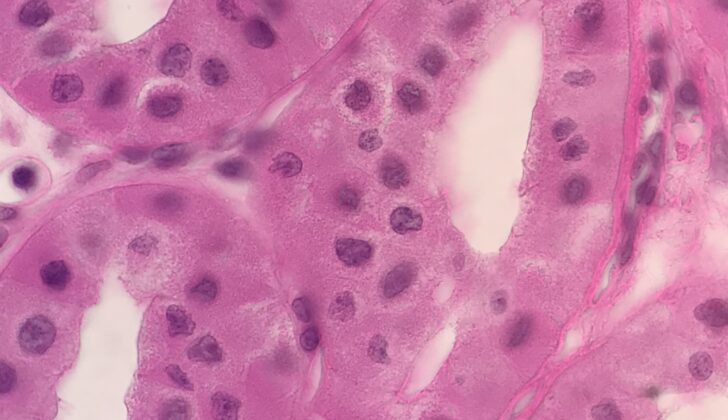What is Renal Oncocytoma?
Renal oncocytomas are non-cancerous kidney tumors that make up 3% to 7% of all kidney tumors. They most often occur in adults, usually around the age of 70. Renal oncocytomas might be found by accident during an unrelated medical examination, or may possibly be identified through a biopsy or removal procedure. These tumors typically look like a well-defined tan or darker reddish-brown lump with a star-like center. Looking at cells under a microscope, they tend to form well-defined clusters with plain cell appearance, regular nuclei (the control center of a cell), noticeable central nucleoli (smaller structures inside the nuclei), and pinkish cell substance. Still, because other conditions can look similar to oncocytoma, diagnosis can be tricky. Usually, a diagnosis is made based on the cellular appearance, or with the use of special staining techniques in more challenging situations. Occasionally, genetic studies might be helpful in confirming a diagnosis.
Despite how they look, renal oncocytomas usually have a very good outcome and typically aren’t associated with serious health problems. However, there are rare instances where the tumor may spread to the liver and bones, and in such cases, it could have fatal results. If the tumor has not spread, removing it through surgery typically cures the problem.
What Causes Renal Oncocytoma?
Renal oncocytomas, a type of kidney tumor, are thought to develop from abnormal growth of certain kidney cells, specifically the intercalated epithelial cells. This abnormal growth is believed to occur after these cells accumulate various genetic mutations.
Risk Factors and Frequency for Renal Oncocytoma
Oncocytomas are a type of kidney tumor, constituting between 3% to 7% of all renal epithelial tumors. Generally, they affect adults over 50 years old and are more common in men. The likelihood of developing an oncocytoma peaks in a person’s seventies, but they are rarely seen in children.
People with Birt-Hogg-Dube syndrome, a rare genetic condition, frequently develop oncocytomas. On average, these patients will experience about 5.3 kidney tumors in their lifetime, primarily oncocytomas and chromophobe renal carcinoma.
Signs and Symptoms of Renal Oncocytoma
Oncocytomas are typically discovered by accident, as patients usually don’t experience any discomfort in the urinary tract. However, there can be symptoms such as visible blood in the urine, pain in the side of the body, or a detectable lump during a physical examination.
Testing for Renal Oncocytoma
Oncocytomas are often identified while doing routine imaging, even though there aren’t clear criteria to separate a harmless oncocytoma from a cancerous kidney lesion. But usually, traits like a central scar and high blood flow can be discovered during the imaging process.
The assessment of a kidney mass could involve biopsy, fine needle aspiration, or resection techniques. As Oncocytomas are generally small, and about 20% to 45% of these small kidney masses turn out to be non-cancerous, some patients may be given the option of just monitoring the mass, rather than removing it right away. If the mass is biopsied, the biopsy can successfully determine the type and grade of the mass in up to 80% of the cases.
If the biopsy sample and the staining patterns are challenging to interpret, additional tests like conventional karyotyping and FISH may be used. These tests check for a specific set of chromosomes (a “diploid karyotype”) with a missing chromosome 1, which would support the diagnosis of an oncocytoma.
Treatment Options for Renal Oncocytoma
Renal oncocytomas, which are types of kidney tumors, can usually be treated by removing only a portion of the kidney, a process known as partial nephrectomy. This, however, depends on the size of the tumor. If partial nephrectomy isn’t possible, then the entire kidney may need to be removed, in a procedure called total nephrectomy.
In a study where 70 patients with renal oncocytomas underwent either total or partial nephrectomy, the surgery was successful in treating the disease in 68 of them. There were two exceptions – one patient had the disease spread to their liver but it did not get worse, and another patient passed away due to the spread of the disease to the bone and liver. This study suggests that although most renal oncocytomas are non-cancerous and can be successfully treated with surgery, there are rare cases where they can spread to other organs.
What else can Renal Oncocytoma be?
Determining whether a tumor is a benign oncocytoma or a harmful cancer mimic can be difficult. Therefore, it’s crucial to use immunohistochemistry, a laboratory process that uses antibodies to detect specific proteins in cells, to help make an accurate diagnosis.
There are several conditions that should be considered when trying to diagnose an oncocytoma, specifically:
- Eosinophilic variant chromophobe renal cell carcinoma
- Succinate dehydrogenase-deficient renal cell carcinoma
- Tubulocystic renal cell carcinoma
- Papillary renal cell carcinoma with eosinophilic cytoplasm
- Epithelioid angiomyolipoma
What to expect with Renal Oncocytoma
Renal oncocytoma is a type of non-cancerous tumor in the kidney that very rarely spreads to other parts of the body, thus, confirming its excellent chances of recovery. Even in the very unusual cases where it spreads to the liver, the prospects remain good.
Even if the oncocytoma has unusual shape or structure, it doesn’t change the fact that patients have an excellent chance of recovering and it is not associated with a severe or aggressive progression of the disease.












